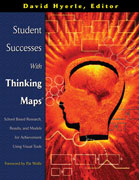



 dent Successes With Thinking Maps®
dent Successes With Thinking Maps®David Hyerle, Editor with Sarah Curtis and Larry Alper coeditors
Chapter 5: Closing the Gap By Connecting Culture, Language, and Cognition
Yvette Jackson, Ed.D.
We believe that literacy for urban learners is best developed when the teacher mediates the learning process by providing lessons that foster social interaction for language development and guide the application of cognitive skills that assist students in constructing and communicating meaning. The Thinking Maps are a core component of the cognitive strategies we provide because they are tools that have a direct impact on how students construct, communicate, and create meaning. In each district in which we work, we have witnessed how teachers immediately employ thinking maps as one of the most used tools of their instructional repertoire. The result has been what administrators and parents associate with the most impressive and valued impact our literacy initiatives has on learning—significant growth in the achievement of students who have previously been labeled as “low achievers.” In Indianapolis, schools have recently experienced a 12–20 point jump in scores, which is significant. While across the state of Indiana, scores have fallen since 1998 by 1.2%, the “vanguard schools” in Indianapolis participating in the literacy initiative experienced an average increase of 10.4%, with seven of the elementary schools showing double-digit gains. In Seattle, a study showed that African American students who failed the reading section of the Washington Assessment of Student Learning (WASL) in 1999 and then spent at least two years with teachers who participated in the initiative passed the 2002 test at twice the rate of those students who spent a year or less with participating teachers.
Thinking processes are universal and thus the Thinking Maps help students transfer these cognitive skills across content areas and grade levels. Children are born understanding cause and effect. They know how to think sequentially. In urban settings where there may be historic underachievement, when we provide tools that enable teachers to build on the capacity of the students to think critically through instruction that provides them with tools to fortify their understanding, competence, and confidence, you have students who are motivated to excel and do excel. It becomes part of the common culture of the classroom, of the school, and as we have seen, of whole systems.
Read the complete chapter in the book Student Successes With Thinking Maps. Key sections from the chapter Closing the Gap By Connecting Culture, Language, and Cognition with excerpts above include:
- How did you come to your work in urban schools?
- Where has this lead you? Tell us about your present work.
- Why are teachers saying there is a gap between teachers and students in urban settings?
- What do you think is key to bridging this gap?
- L=(U+M)(C1+C2)
- Speaking of Confidence, what is the Pedagogy of Confidence you talk about and how does that relate to your identification of the Thinking Maps as essential tools for learning?
- What do you consider the critical learning needs of students in underachieving schools?
- How do you reaaly work on developing memory as something that is important to address as part of the mediation of a student's learning?
- What specific experiences have you observed in the districts in which you work that have demonstrated the impact of the Thinking Maps on teachers perceptions about learning and teaching?
Y vette Jackson, Ed.D. is the Executive Director of the National Urban Alliance for Effective Education. In this capacity, she works with school district administrators and teachers across the country to customize and deliver systemic approaches to accelerate literacy and achievement for urban students. She oversees the design of tailored courses of study in cognitive strategies and instructional practices that focus on literacy in the context of culture, language, and cognition.
vette Jackson, Ed.D. is the Executive Director of the National Urban Alliance for Effective Education. In this capacity, she works with school district administrators and teachers across the country to customize and deliver systemic approaches to accelerate literacy and achievement for urban students. She oversees the design of tailored courses of study in cognitive strategies and instructional practices that focus on literacy in the context of culture, language, and cognition.
![]() Click here (pdf file) to download Research Highlights from
Click here (pdf file) to download Research Highlights from
Student Successes With Thinking Maps
For more on Student Successes With Thinking Maps go to the following links: